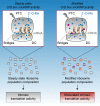2'-O-Methylation of Ribosomal RNA: Towards an Epitranscriptomic Control of Translation?
- PMID: 30282949
- PMCID: PMC6316387
- DOI: 10.3390/biom8040106
2'-O-Methylation of Ribosomal RNA: Towards an Epitranscriptomic Control of Translation?
Abstract
Ribosomal RNA (rRNA) undergoes post-transcriptional modification of over 200 nucleotides, predominantly 2'-O-methylation (2'-O-Me). 2'-O-Methylation protects RNA from hydrolysis and modifies RNA strand flexibility but does not contribute to Watson-Crick base pairing. The contribution of 2'-O-Me to the translational capacity of ribosomes has been established. Yet, how 2'-O-Me participates in ribosome biogenesis and ribosome functioning remains unclear. The development of 2'-O-Me quantitative mapping methods has contributed to the demonstration that these modifications are not constitutive but rather provide heterogeneity to the ribosomal population. Moreover, recent advances in ribosome structure analysis and in vitro translation assays have proven, for the first time, that 2'-O-Me contributes to regulating protein synthesis. This review highlights the recent data exploring the impact of 2'-O-Me on ribosome structure and function, and the emerging idea that the rRNA epitranscriptome is involved in translational control.
Keywords: 2′-O-methylation; fibrillarin; mRNA translation; ribosomal RNA; ribosome heterogeneity; snoRNP.
Conflict of interest statement
The authors declare no conflict of interest.
Figures


References
Publication types
MeSH terms
Substances
LinkOut - more resources
Full Text Sources
Other Literature Sources

